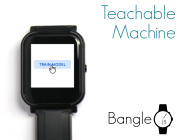
Controlling Espruino from Tensorflow on the Desktop
In this tutorial we'll teach an AI to recognise features in video with a webcam, and to then send a signal from the PC - via Bluetooth - to a Bangle.js (or other Bluetooth Espruino device) to make something happen.
In this case we'll make a website that reminds you not to pick your nose by buzzing a Bangle.js when it thinks it sees your finger near your nose.
Google provides a website called Teachable Machine that will allow us to train our own neural network in a matter of seconds, and even provides you with the code you'll need to use it.
- First, go to https://teachablemachine.withgoogle.com/
- Choose
Get Started,Image Project, andStandard Image model. Now you have two classes - Click on the text
Class 1and typenormal - Click on
Webcamunder it (give permission if needed) - Make sure you're in frame and then hold the
Hold To Recordbutton and make some facial expressions, look up, down, left, right etc - the aim is to train the model with your normal look - Click on the text
Class 2and typepicking - Now train
pickingwith the webcam too, ensuring that you only press theHold To Recordbutton with your finger in frame near your nose - When you're happy click the
Trainbutton and wait a minute or two - After this you can try out your nose picking detector
- When it's done, click
Export Model - Click
Upload by cloud model - Now go to Github and create a new project so you can have an HTTPS-hosted website (or just host the file off
localhostvia HTTP).- For more information on this see the Web Bluetooth tutorial
- Note: The p5.js hosting option shown in Teachable Machine will not work with Web Bluetooth
- Copy the HTML code from Teachable Machine's Export page into a new
index.htmlfile - Right before
<script type="text/javascript">add the line<script src="https://www.puck-js.com/puck.js"></script> - At the end of the code, replace the
predictfunction with:
// run the webcam image through the image model
async function predict() {
// predict can take in an image, video or canvas html element
const prediction = await model.predict(webcam.canvas);
for (let i = 0; i < maxPredictions; i++) {
const classPrediction =
prediction[i].className + ": " + prediction[i].probability.toFixed(2);
labelContainer.childNodes[i].innerHTML = classPrediction;
}
// Check if it's likely the nose was picked for a while
if (prediction[1].probability > 0.5) {
pickCounter++;
// If so, send some JS to Bangle.js to make it buzz
if (pickCounter==20 && connected)
Puck.write("Bangle.buzz()\n");
} else {
pickCounter = 0;
}
}
// Web Bluetooth connections can only be started in response
// to a user's action, so this boilerplate just puts something
// over the whole screen that must be clicked first
let connected = false;
let pickCounter = 0;
Puck.modal(function() {
Puck.write("\n", function() { // force a connection
connected = true;
});
});
- Save, and you're done. Load the page up in your browser, and you must now click on the page once and choose your Bangle.js
from the Web Bluetooth menu, then click the
Startbutton to enable the webcam.
Now, if you start to raise your finger to pick your nose, Tensorflow will detect it and will make the Bangle.js buzz to warn you!
This page is auto-generated from GitHub. If you see any mistakes or have suggestions, please let us know.